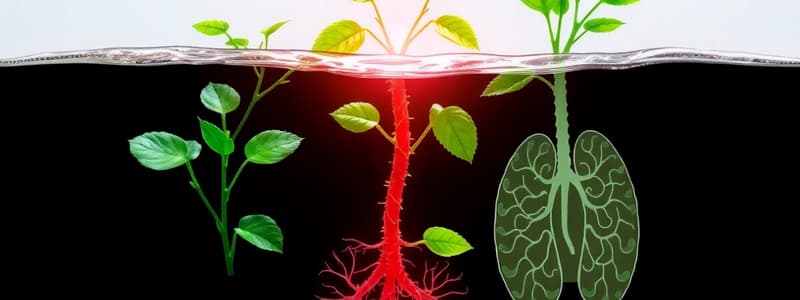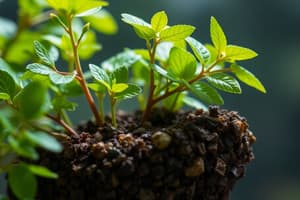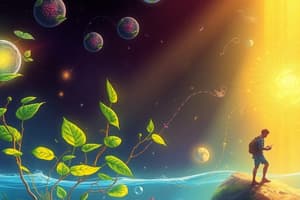Podcast
Questions and Answers
What are autotrophs?
What are autotrophs?
Organisms that make their own food.
What are heterotrophs?
What are heterotrophs?
Organisms that have to consume food and cannot make their own.
What are thylakoids?
What are thylakoids?
Chlorophyll sacs in chloroplasts, where light-dependent reactions take place.
What is a granum?
What is a granum?
What is the Calvin Cycle?
What is the Calvin Cycle?
What is lactic acid fermentation?
What is lactic acid fermentation?
What is cellular respiration?
What is cellular respiration?
What does aerobic mean?
What does aerobic mean?
What does anaerobic mean?
What does anaerobic mean?
What is photosynthesis?
What is photosynthesis?
What is a chloroplast?
What is a chloroplast?
What is glycolysis?
What is glycolysis?
What is the Krebs Cycle?
What is the Krebs Cycle?
What is alcohol fermentation?
What is alcohol fermentation?
What are electron carriers?
What are electron carriers?
Flashcards are hidden until you start studying
Study Notes
Heterotrophs and Autotrophs
- Heterotrophs are organisms that cannot produce their own food and must consume other organisms to obtain energy.
- Autotrophs are organisms that can produce their own food through photosynthesis, using sunlight, carbon dioxide, and water.
Photosynthesis
- Photosynthesis is the process by which plants and other autotrophs convert light energy into chemical energy in the form of glucose.
- Photosynthesis occurs in organelles called chloroplasts, which contain chlorophyll, a pigment that absorbs light energy.
- Chloroplasts contain stacks of thylakoids, which are interconnected membranous sacs where light-dependent reactions take place. These sacs are stacked into grana.
- Calvin Cycle is the light-independent stage of photosynthesis, where carbon dioxide is converted into glucose.
- Glucose is a sugar that provides energy for plants and other organisms.
Cellular Respiration
- Cellular respiration is the process by which organisms break down glucose to release energy in the form of ATP (Adenosine triphosphate).
- Aerobic respiration requires oxygen and produces carbon dioxide, water, and ATP.
- Anaerobic respiration does not require oxygen and produces lactic acid or alcohol as byproducts.
Glycolysis
- Glycolysis is the first step in cellular respiration and occurs in the cytoplasm.
- Glucose is broken down into two molecules of pyruvic acid, producing a net gain of 2 ATP.
Krebs Cycle
- The Krebs Cycle (also known as the citric acid cycle) completes the breakdown of glucose and occurs in the mitochondria.
- Pyruvic acid is converted into acetyl-CoA, which enters the Krebs Cycle.
- The Krebs Cycle produces ATP, NADH, and FADH2.
Electron Transport Chain
- The electron transport chain is the final stage of cellular respiration and occurs in the mitochondria.
- Electrons from NADH and FADH2 are passed down a chain of protein carriers, releasing energy that is used to produce ATP.
- Oxygen acts as the final electron acceptor, forming water.
Fermentation
- Fermentation is an anaerobic process that occurs when oxygen is not available.
- Lactic acid fermentation occurs in human muscles during strenuous activity, producing lactic acid, which causes muscle fatigue.
- Alcohol fermentation occurs in yeast and some bacteria, producing ethanol and carbon dioxide.
Studying That Suits You
Use AI to generate personalized quizzes and flashcards to suit your learning preferences.




